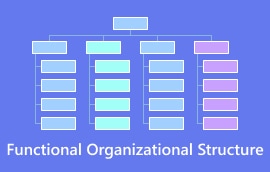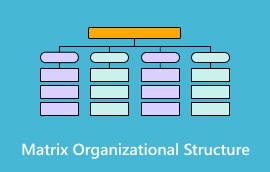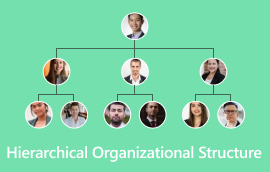Dowiedz się więcej o pionowej strukturze organizacyjnej
Zrozumienie struktury organizacyjnej jest jednym z najlepszych sposobów na zwiększenie wydajności i ułatwienie rozwoju w ciągle zmieniającej się dziedzinie zarządzania biznesem. pionowa struktura organizacyjna wywiera istotny wpływ na sposób działania przedsiębiorstw i charakter decyzji, ponieważ koncentruje się na swoich odrębnych rolach i hierarchii poziomów.
Zgodnie z tym artykuł ten definiuje pionowe struktury organizacyjne, omawia ich zalety i wady oraz podaje przykłady ze świata rzeczywistego, aby pokazać, jak można je wykorzystać. Zapewniamy również atrakcyjną reprezentację graficzną, aby lepiej pomóc Ci zrozumieć niektóre subtelności tej struktury i pomóc Ci określić, czy jest to idealny wybór dla Twojej firmy. Przejdźmy przez świat pionowej organizacji i co ona robi pod względem wpływu na sukces biznesowy.

- Część 1. Czym jest pionowa struktura organizacyjna
- Część 2. Zalety pionowej struktury organizacyjnej
- Część 3. Wady pionowej struktury organizacyjnej
- Część 4. Przykłady pionowych struktur organizacyjnych
- Część 5. Najlepsze narzędzie do tworzenia wykresu pionowej struktury organizacyjnej
- Część 6. Najczęściej zadawane pytania dotyczące pionowej struktury organizacyjnej
Część 1. Czym jest pionowa struktura organizacyjna
W pionowej strukturze organizacyjnej władza i komunikacja zazwyczaj przesuwają się w dół hierarchicznej drabiny od najwyższych rangą menedżerów i przełożonych do najniższych rangą pracowników. Dobrze zdefiniowany łańcuch dowodzenia, scentralizowane podejmowanie decyzji i wyraźne linie autorytetu to cechy tej struktury organizacyjnej. Ta forma struktury organizacyjnej jest dość rozpowszechniona, szczególnie wśród dużych korporacji. Firmy takie jak Apple, Tesco i Amazon stosują ten rodzaj struktury.
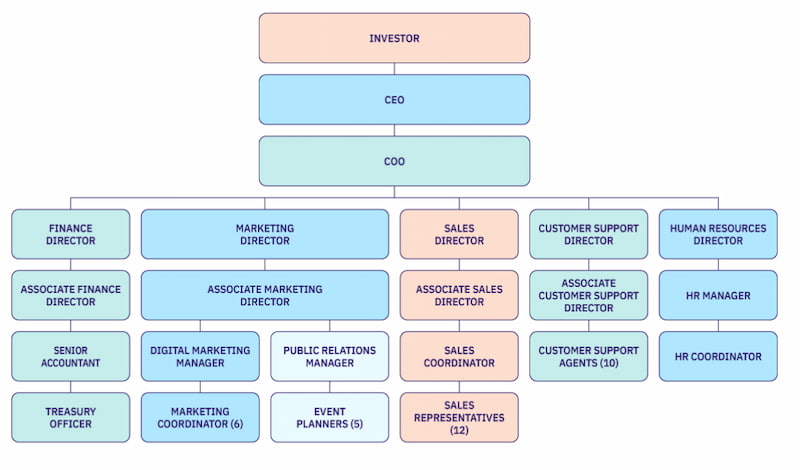
Jasne linie autorytetu: Autorytet przekazywany jest z góry na dół, od wyższego do niższego szczebla, tworząc rozpoznawalną hierarchię, w której każdy członek ma bezpośredniego przełożonego.
Centralne podejmowanie decyzji: W organizacji dominuje silnie hierarchiczny styl podejmowania decyzji oraz koncentracja uprawnień decyzyjnych na najwyższych szczeblach.
Działkowość: Podobnie jak w innych strukturach firm, ten rodzaj wykresu jest również podzielony według stanowiska. Operacje Suchintos, finanse i zasoby ludzkie, z których każdy specjalizuje się w określonym obszarze funkcjonalnym.
Ograniczona autonomia dla niższych szczebli: Niższe szczeble hierarchii charakteryzują się mniejszą autonomią w podejmowaniu decyzji.
Zdefiniowane role i obowiązki: Każde stanowisko ma jasno określony zakres obowiązków, co zmniejsza niepewność i jasno określa pracę w całej organizacji.
Część 2. Zalety pionowej struktury organizacyjnej
• Skuteczne podejmowanie decyzji: Ponieważ w organizacji pionowej uprawnienia są konsolidowane i delegowane z góry na dół, decyzje można podejmować szybko i skutecznie.
• Uproszczenie nadzoru: Ponieważ każdy menedżer odpowiada za określoną grupę osób, jasna hierarchia ułatwia sprawniejsze zarządzanie personelem i monitorowanie go.
• Jednolitość i spójność: Zasady i procedury są zazwyczaj standaryzowane pionowo w całej organizacji.
• Dobrze zorganizowana ścieżka kariery: Pracownicy są zmotywowani i mogą rozwijać swoje kariery, gdy widzą jasną ścieżkę awansu w organizacji.
Część 3. Wady pionowej struktury organizacyjnej
• Zmniejszona elastyczność: Ponieważ struktury pionowe są często nieelastyczne, przedsiębiorstwom trudno jest szybko dostosowywać się do zmian na rynku lub w branży.
• Możliwość silosów informacyjnych: Silosy informacyjne mogą być wynikiem ograniczeń w udostępnianiu informacji pomiędzy działami i szczeblami.
• Obniżone morale wśród pracowników: Pracownicy na niższych stanowiskach mogą czuć się odcięci od kierownictwa wyższego szczebla i procesu podejmowania decyzji.
• Zależność od świetnego przywództwa: Skuteczność liderów struktury pionowej jest kluczowa dla jej sukcesu. Każdy poziom słabego przywództwa ma duży wpływ na organizację jako całość.
Część 4. Przykłady pionowych struktur organizacyjnych
PepsiCo jest jednym z takich przykładów. PepsiCo ma niezwykle pionową strukturę organizacyjną z wyraźną linią dowodzenia i działaniami hierarchicznymi. Dyrektor generalny PepsiCo, Ramon Laguarta, ma ogromny autorytet w organizacji i utrzymuje kontrolę od góry do dołu. Prezes, dyrektor generalny lub wiceprezes wykonawczy nadzoruje każdy z działów i departamentów, które składają się na operacje PepsiCo. Poniżej przedstawiono strukturę organizacyjną PepsiCo.
PepsiCo jest w stanie skuteczniej zarządzać swoimi operacjami międzynarodowymi dzięki swojej pionowej strukturze organizacyjnej, która charakteryzuje się przejrzystym łańcuchem dowodzenia i hierarchicznym podejmowaniem decyzji. Ułatwia to jasne monitorowanie i zarządzanie wszystkimi aspektami działalności organizacji, od góry do dołu. Ponadto pionowa struktura organizacyjna PepsiCo sprzyja zdolności firmy do wdrażania wszystkich polityk, wyborów i planów z wydajnością.
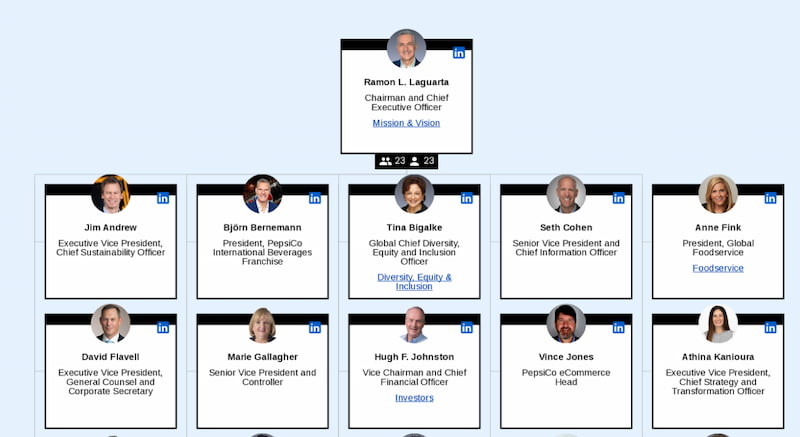
Część 5. Najlepsze narzędzie do tworzenia wykresu pionowej struktury organizacyjnej
Widząc różne opisy pionowego schematu organizacyjnego możemy pomyśleć, że jest to również skuteczne medium do uczynienia zespołu funkcjonalnym i zorganizowanym. Dlatego jeśli uważasz, że potrzebujesz pionowej struktury organizacyjnej, to posiadanie fantastycznego narzędzia, takiego jak MindOnMap sprawia, że jest to bardzo łatwe do wykonania. Jest to popularne narzędzie do mapowania, które zapewnia fantastyczną platformę dla wielu użytkowników do tworzenia ich unikalnych map. Ponadto narzędzie zapewnia szeroki zakres formularzy i komponentów, aby wzmocnić aurę Twojego wykresu. Dlatego użycie MindOnMap do stworzenia pionowego wykresu organizacyjnego jest niewątpliwie mądrym wyborem.
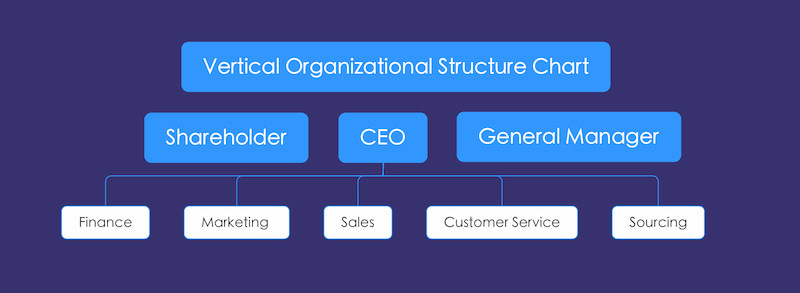
Kluczowa cecha
• Ogromne szablony wykresów.
• Przyjazny dla użytkownika interfejs.
• Funkcja współpracy.
• Udostępnianie linku.
• Wbudowane motywy i style.
Część 6. Najczęściej zadawane pytania dotyczące pionowej struktury organizacyjnej
Która struktura organizacyjna jest lepsza: pozioma czy pionowa?
W zależności od celów, struktury poziome zachęcają do współpracy, podczas gdy struktury pionowe zapewniają odrębne hierarchie. W głębszej analizie, Vertical ma typowy limit z wkładem pracowników. Z drugiej strony, poziomy schemat organizacyjny jest aktywny w promowaniu uczestnictwa pracowników.
Która firma ma strukturę pionową?
Tradycyjne firmy, takie jak General Electric i Ford Motor Company, powszechnie przyjmują struktury pionowe. Te organizacje są ustrukturyzowane z różnymi poziomami uprawnień i obowiązków.
Jakie trudności wiążą się z posiadaniem struktury pionowej?
Przeszkody w komunikacji mogą wynikać z architektur pionowych, ponieważ informacje mogą być opóźnione lub błędnie interpretowane podczas przechodzenia przez kilka szczebli zarządzania. Ponadto hierarchia ta może prowadzić do sztywności, która utrudnia organizacji szybkie przyjmowanie nowych pomysłów lub dostosowywanie się do zmian.
Czy lepiej Ci się pracuje w organizacji poziomej czy pionowej?
Zależy to od osoby; niektórzy doceniają poziome środowiska do współpracy, podczas gdy inni uważają pionowe struktury za bardziej przejrzyste. Oznacza to, że jeśli Twoja praca jest pracą zespołową, musisz używać poziomego schematu organizacyjnego. Ale jeśli Twoja praca wymaga podejmowania decyzji przez jedną osobę, taką jak menedżer, to pionowy schemat organizacyjny jest dla Ciebie najlepszy.
Czy przedsiębiorstwa mogą mieć komponenty pionowe i poziome?
Rzeczywiście, wiele firm korzysta z hybrydowych struktur organizacyjnych, które łączą aspekty modeli pionowych i poziomych. Ta metoda pozwala firmom wykorzystać korzyści współpracy i elastyczności oferowane przez struktury poziome, zachowując jednocześnie przejrzystość i kontrolę zapewniane przez hierarchie pionowe.
Wniosek
Gdy dochodzimy do wniosku, możemy teraz powiedzieć, że pionowe struktury są rzeczywiście pomocne w zarządzaniu firmą lub organizacją. Oferują harmonijny proces dla zespołu, a także dają autorytet osobom na szczycie. Co więcej, jeśli potrzebujesz tego rodzaju struktury, to możemy zobaczyć, że MindOnMap jest dla Ciebie świetnym wyborem. Oferuje wszystkie funkcje, których potrzebujesz, aby stworzyć najlepszą schematy organizacyjne dla Ciebie. Więc na co czekasz? Użyj go i z łatwością uzyskaj swój idealny wykres.








